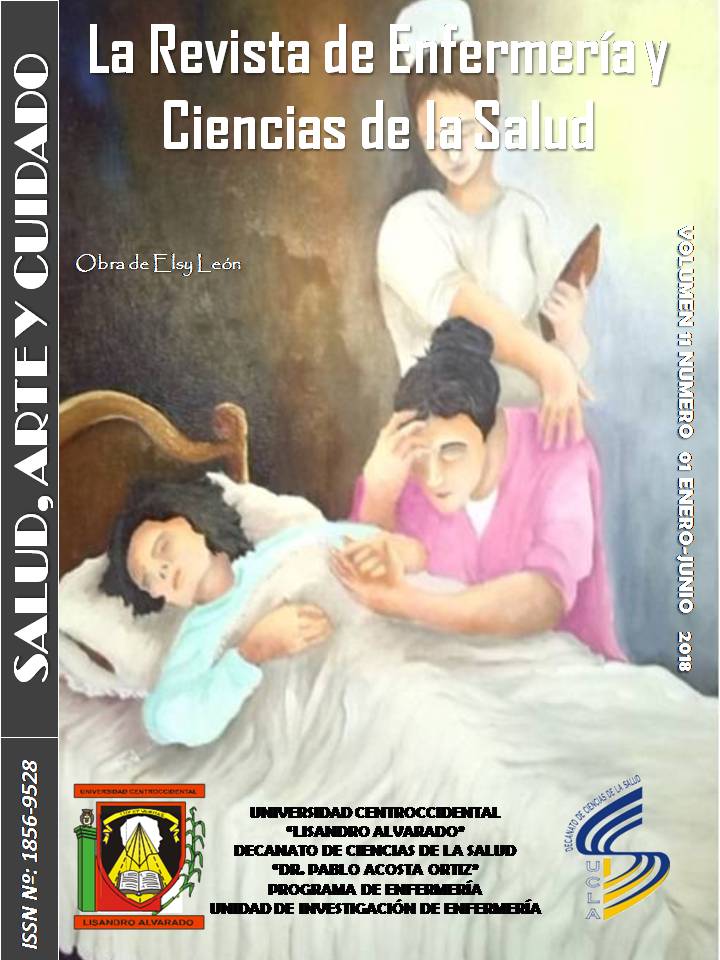SYNDROME SECONDARY TO THE USE OF OPIOIDS AND BENZODIAZEPINES IN NEONATAL AND PEDIATRIC PATIENTS
Keywords:
abstinence syndrome, opioids, benzodiazepines, neonates, pediatricAbstract
The study was carried out with the objective of evaluating the appearance of the withdrawal syndrome secondary to the prolonged use of opioids and benzodiazepines in neonatal and pediatric patients in the polyvalent intensive care unit (ICU) at the Pediatric Teaching Hospital “Agustin Zubillaga” (PTHAZ). It was developed in the positivist paradigm, a quantitative approach, within the framework of a descriptive study, under the modality of field research specifically of transversal nature. The study population was made up of seven (07) neonatal and pediatric patients who received prolonged (more than five days) opioids and benzodiazepines in the ICU of the PTHAZ. An instrument for data collection was applied to them. The Finnegan Scale was applied to neonatal patients. The Sophia Observation Withdrawal Symptoms Scale (SOS), was applied to pediatric patients. The analysis of the results was carried out through the Microsoft Excel program. These were showed in statistical charts and graphs. As a result, the neonatal and pediatric patients developed 100% SA after receiving fentanyl and/or midazolam for more than 5 days. The most frequent symptoms in the neonatal patients were: insomnia, excessive crying, increased Molar reflex, tremors, sweating, tachypnea, sneezing, excessive suction, inappetence and diarrhea. In pediatric patients it was observed that the most usual symptoms were: tachycardia, tachypnea, fever, anxiety, tremors, inconsolable crying, insomnia and diarrhea.
Downloads
References
2. Burastero, M.; Telechea, H.; González, S.; Manassi, A.; Méndez, P.; Brunetto, M. y Menchaca, A. Incidencia del síndrome de abstinencia en niños críticamente enfermos. Archivos de Pediatría del Uruguay [Revista en línea], 88 (1), 6-11. Consultado el 27/06/2017 en: http://www.sup.org.uy/web2/ volumen-88-suplemento-1
3. Cuesta, J.; Espinosa, A. y Val, C. Síndrome de abstinencia neonatal. Enfermería Integral [Revista en línea], 103-Diciembre 2013, 24-28. Consultado el 25/05/2017 en: http://www.enfervalencia.org/ei/ 103/enf-integ-103.pdf
4. Fernández, F. (2013). Síndrome de abstinencia en UCIP [Publicación en línea]. Consultado el 08/06/2017 en: https://www.secip.com/publicaciones-relacionadas/protocolos/category/26-abstinencia-sindrome-de-abstinencia-sindrome-de
5. Rubio, M. Destete de opiáceos: Cómo evitar el síndrome de abstinencia [Documento en línea]. Ponencia presentada en el 3º Congreso Argentino de Neonatología. Panamericano Buenos Aires Consultado el 25/05/2017 en: http://studylib.es/doc/ 6174286/destete-de-opi%C3%A1ceos--c%C3%B3mo -evitar-el-s%C3%ADndrome-de-abstinenc
6. Escobedo, R. y Diez, E. (2016). Control y prevención del síndrome de abstinencia en UCI pediátrica: a propósito de un caso. Revista Médica Electrónica, PortalesMedicos.com [Revista en línea]. Consultado el 04/06/2017 en: https://www.revista-portales médicos.com/revista-medica/síndrome-abstinencia-uci-pediátrica/
7. Carrillo, R.; Carrillo, J.; Carrillo, L. y Carrillo, C. Síndrome de supresión secundaria a la suspensión de la sedoanalgesia en el enfermo grave. Revista de la Asociación Mexicana de Medicina Crítica y Terapia Intensiva 2010 [Revista en línea], XXIV (3), 132-137. Consultado el 25/05/2017 en: http://new.medigraphic. com/cgi-bin/resumen.cgi?IDARTICULO=24707
8. Rojas, D. y Fernández, J. Dexmedetomidina en pacientes pediátricos con requerimientos de ventilación mecánica y sus efectos sobre el síndrome de abstinencia 2009. Universidad del Rosario, Bogotá DC. Consultado el 16/05/2017 en: http://repository.urosario.edu.co/handle/10336/1297
9. Fernández, F.; Gaboli, M.; González, R.; Gómez, P.; Fernández, S.; Murga, V.; Serrano, O.; Sánchez, J. y Payo, R. Síndrome de abstinencia en Cuidados Intensivos Pediátricos. Incidencia y factores de riesgo 2013. Consultado el 16/05/2017 en: http://www.medi ntensiva.org/es/sindrome-abstinencia-cuidados-intensivos-pediatricos-/articulo/S0210569112000952/
10. Chávez, R. (2003). Sedación, analgesia y relajación en la Unidad de Cuidados Intensivos Pediátricos del Hospital Edgardo Rebagliati Martins-Essalud, enero a diciembre del 2002 [Trabajo de investigación de postgrado en línea]. Universidad Nacional Mayor de San Marcos, Perú. Consultado el 25/05/2017 en: http://cybertesis.unmsm.edu.pe/bitstream/cybertesis/1761/1/Chavez_ar.pdf
Published
How to Cite
Issue
Section
Derechos del/de autor/es a partir del año de publicación
Esta obra está bajo la licencia:
Creative Commons Reconocimiento-NoComercial-CompartirIgual 4.0 Internacional (CC BY-NC-SA 4.0)
Las opiniones expresadas por los autores no necesariamente reflejan la postura del editor de la publicación ni de la UCLA. Se autoriza la reproducción total o parcial de los textos aquí publicados, siempre y cuando se cite la fuente completa y la dirección electrónica de esta revista. Los autores(as) tienen el derecho de utilizar sus artículos para cualquier propósito siempre y cuando se realice sin fines de lucro. Los autores(as) pueden publicar en internet o cualquier otro medio la versión final aprobada de su trabajo, luego que esta ha sido publicada en esta revista.







